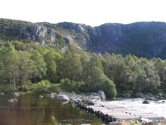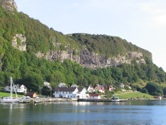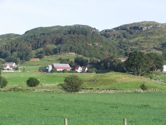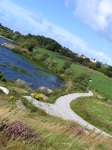I’m enjoying a month back in my hometown where I’m trying to teach myself basic reading of German and reading about treason trials and political retribution in early postwar Norway and Denmark. I am also enjoying this time back here to hang out with my friends and relatives of course.
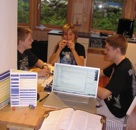
The most fun way of connecting with my young 13 year old cousin is by playing role-playing games, which is something I have also very much enjoyed since as long as I was old enough to read. I sent my Dungeons & Dragons books, etc. to my mother’s apartment here in Norway and have kicked my rusty old mind into gear in order to create some adventures for him and his friends (two other 14 year old boys in the 9th grade in Norwegian school, plus another to join next week). Today, during our little gaming session my enthusiastic young adventurers decided that they wanted to lay a trap for a powerful and diabolical monster (a Night Hag) who was preying upon a village at night (For the record, I usually but not always try to subvert the simple Good/Evil binaries and various race-based generalizations which are a trademark of such games). It is a bit complicated to explain for those who don’t know how these games work, but suffice to say my players decided to raid the Night Hag’s cave while she was out hunting and steal something called a Heartstone inside, which she would notice immediately. They would then await her return and hope that she would fall for the trap when they would try to ambush her.
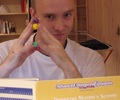
They wanted to dig a large pit in front of the Night Hag’s cave. Unfortunately, there is nothing but stone outside the cave, which is on a mountain side. Their priest has a divine spell which can turn stone to clay, but only 30 cubic feet per spell cast. If they can cast the spell 4 times, and without using other creative techniques to remove the stone, they can turn a total of 120 cubic feet of solid stone into soft clay which they can then dig out, fill with wooden stakes prepared by the cooperative villagers and then hide the trap with an illusion to deceive the Night Hag (who has some spell resistance, but they don’t know that).

This is all very technical and somewhat irrelevant, but to make a long story short, they had to calculate how wide, long and deep they wanted to create their pit. At one point this meant that, in order to calculate one possible configuration of the size, they had to figure what 120 divided by 16 was. I ruled that they were not allowed to use a calculator (on their cellphones) since I wanted to see how my young friends did at calculating this out and was amazed to discover that after 15 minutes of trying, they were not able to figure out 120/16 by hand. I got the answers 6 from one boy while another emerged from a trance of complicated and bizarre notations to declare, if momentarily, the answer to be 25.

Now, these kids are actually very smart. They had lots of great ideas during the adventure and were able to solve all of the other puzzles I created for them (including a classic one involving riddles and mirrors to open a secret door). They were also surprisingly worldly in their estimations about how various other people in this fantasy world would behave. That is, by observing their internal debate over how to interact with people they met they showed they were able to make very complex and realistic appraisals of how strangers would behave in reaction to certain situations and adjusted their own decision making in accordance, something which reveals considerable experience in social interaction and overall maturity.
In addition, while we played the game almost all in Norwegian, whenever characters spoke, or riddles or inscriptions were read, it was in English (both for my convenience, since I’m more eloquent in English, but also in order to create a certain mystique) and these 13-14 year olds had almost no problems understanding any of the English in the dialogue or puzzles or replying – on behalf of their characters, in English. The only exceptions were not understanding the word “passageway” and sometimes using distinctly Norwegian word order in their English sentences.
However, while they came up with creative solutions to other various problems, simple math like the division of 16 into 120 stumped them (Disclaimer: I also suck at math really badly, so I was amazed, if momentarily comforted, to find anyone with greater difficulty than myself, albeit among those half my age). I asked when they learnt how to do division at school and they said that they remember vaguely having learnt how to do something like 120/16 in 6th or 7th grade but can’t remember how it was done. I don’t know how representative these boys are but I couldn’t help but wonder how old the average child in other countries, especially in East Asia where I have spent so much time recently, can do this kind of math? Then again, if they are not to be engineers or mathematicians, does it matter in a world of cellphone calculators?
 Two Korean friends, Seyeon and Youngsoo, visited me for a few days in Stavanger before continuing their month of travel around Europe. I treated them to some outdoor fun, a stroll around old Stavanger, and splashed about in a forest lake nearby my apartment. We rode the Clipper tour boat into the beautiful Lysefjorden and were lucky enough to get warmth and sun with only moderate cloud cover. I took them walking about the city and Sandnes and up nearby Dalsnuten, probably the shortest climb nearby and fitting for a couple of city slickers.
Two Korean friends, Seyeon and Youngsoo, visited me for a few days in Stavanger before continuing their month of travel around Europe. I treated them to some outdoor fun, a stroll around old Stavanger, and splashed about in a forest lake nearby my apartment. We rode the Clipper tour boat into the beautiful Lysefjorden and were lucky enough to get warmth and sun with only moderate cloud cover. I took them walking about the city and Sandnes and up nearby Dalsnuten, probably the shortest climb nearby and fitting for a couple of city slickers. 

